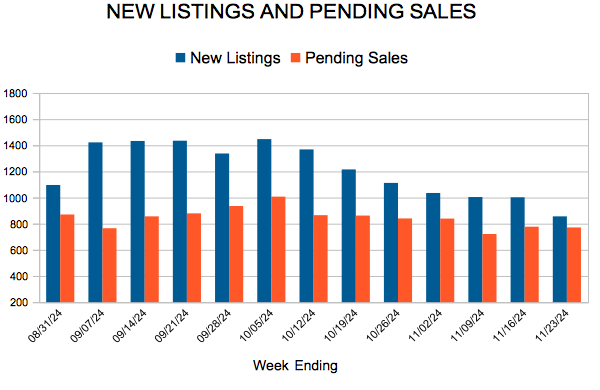Inventory
Weekly Market Report
 For Week Ending November 30, 2024
For Week Ending November 30, 2024
The majority of new single-family housing starts in 2023 were built on slab foundations, according to the National Association of Home Builders’ analysis of the Survey of Construction (SOC), with 72.4% of new homes built on slabs last year, compared to 45.8% in 2000. 16.6% of new homes were built with full or partial basements in 2023, down from 19.6% in 2022.
IN THE TWIN CITIES REGION, FOR THE WEEK ENDING NOVEMBER 30:
- New Listings decreased 34.4% to 515
- Pending Sales decreased 10.7% to 592
- Inventory increased 5.5% to 9,043
FOR THE MONTH OF OCTOBER:
- Median Sales Price increased 4.2% to $380,500
- Days on Market increased 21.6% to 45
- Percent of Original List Price Received decreased 0.7% to 97.8%
- Months Supply of Homes For Sale increased 8.0% to 2.7
All comparisons are to 2023
Click here for the full Weekly Market Activity Report. From MAAR Market Data News.
Mortgage Rates Continue to Decrease

December 5, 2024
This week, mortgage rates decreased to their lowest level in over a month. Despite just a modest drop in rates, consumers clearly have responded as purchase demand has noticeably improved. The responsiveness of prospective homebuyers to even small changes in rates illustrates that affordability headwinds persist.
Information provided by Freddie Mac.
New Listings and Pending Sales
Inventory
Weekly Market Report
 For Week Ending November 23, 2024
For Week Ending November 23, 2024
U.S. homeowners with a mortgage have seen their equity increase by a total of $1.3 trillion since the second quarter of 2023, an 8% increase year-over-year, according to CoreLogic’s Q2 2024 Homeowner Equity Insights report. In that time, the average homeowner gained approximately $25,000 in equity, with Maine, California, and New Jersey homeowners seeing the largest average equity gains in the nation.
IN THE TWIN CITIES REGION, FOR THE WEEK ENDING NOVEMBER 23:
- New Listings increased 69.2% to 856
- Pending Sales increased 43.6% to 771
- Inventory increased 6.5% to 9,414
FOR THE MONTH OF OCTOBER:
- Median Sales Price increased 4.1% to $380,000
- Days on Market increased 21.6% to 45
- Percent of Original List Price Received decreased 0.7% to 97.8%
- Months Supply of Homes For Sale increased 8.0% to 2.7
All comparisons are to 2023
Click here for the full Weekly Market Activity Report. From MAAR Market Data News.
The 30-Year Fixed-Rate Mortgage Inches Down

November 27, 2024
The 30-year fixed-rate mortgage moved down this week, but not by much. Rates have been relatively flat over the last few weeks as the market waits for more clarity on specific economic policies. Potential homebuyers are also waiting on the sidelines, causing demand to be lackluster. Despite the low sales activity, inventory has only modestly improved and remains dramatically undersupplied.
Information provided by Freddie Mac.
New Listings and Pending Sales
Inventory
- « Previous Page
- 1
- …
- 20
- 21
- 22
- 23
- 24
- …
- 49
- Next Page »







